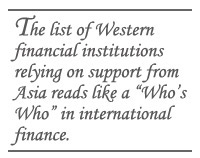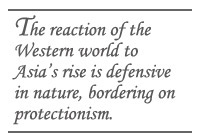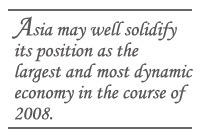Is the Sun Setting on US Dominance? – Part I
Is the Sun Setting on US Dominance? – Part I

SINGAPORE: Just before our eyes a tectonic shift in the global economy is taking place – the Asian economies rising to replace the US as the dominating global economic power. Absolute figures may still give primacy to the US, but emerging trends suggest its grip on the steering wheel is slipping.
The most persuasive signal is that Asia has decoupled, with a decreasing dependence on the US. The Economist reported in February 24, 2007, that the increase in China’s exports accounted for 2.2 percent of the country’s 11 percent GDP growth in 2006, down from 2.7 points in 2005. The figure for 2007 was expected to shrink to 1.6 points. Statistics from the Asian Development Bank show that over the last five years domestic demand, primarily investment but also consumption, amounts to more than 80 percent of contributions to growth. The Asian Development Bank’s outlook for 2007 reports that the US, Europe and Japan – the G-3 – accounted for 43.3 percent of Asia’s exports in 2005 compared to 53.2 percent in 1985.

The world’s savings also take place in Asia, excluding the Middle East and its petro-economy. Asia may not like it, but most on the continent have acquiesced in allowing reputable Western financial institutions to shuffle their savings around, investing them as deemed most profitable. However, most of Asia’s financial institutions wisely did not embrace the risky financial instruments that included sub-prime mortgages originating from the US. The sub-prime crisis – triggered by increasing defaults as housing prices slip in the US and homeowners cannot afford rising interest rates – revealed that these venerable Wall Street firms are less than perfect. In fact, many firms sought rescue from Asia’s growing wealth funds.
The list of Western financial institutions relying on support from Asia reads like a “Who’s Who” in international finance: For example, Singapore’s General Investment Corporation took a stake of US$9.7 billion in UBS, China Investment Corporation channeled US$5 billion into Morgan Stanley.
The support does not signify control or ownership, but does signal that global investment decisions can no longer be made without hearing Asia out. An augury of what the world can expect surfaced in February 2008: The mining giant BHP wanted to acquire its competitor Rio Tinto to create a juggernaut sitting on one-third of the world’s trade in iron ore and the biggest producer of aluminum and coal. China feared that the new company would use its power to push up prices and stepped in to prevent the merger. With a war chest of US$120 billion, the Chinese aluminum company Chinalco entered the fray offering to bid for Rio Tinto.

Multinational companies originating in Asia, excluding Japan, not only emulate existing Western multinationals, but also forge their own path. Companies from small nation-states like Singapore are active, as can be seen with Singtel and DBS, both of which invest in other Asian countries, but still hold back from the global scene. Chinese and Indian companies demonstrate no such modesty: Chinese companies like Lenovo, Petrochina and CNOOC spread their wings globally, and Indian companies like Mittal Steel, Tata, Wipro and Infosys also enter the big game.
Asian companies are active in mergers and acquisitions, as seen with Lenovo’s purchase of IBM’s computer division. India’s Mittal Steel bought Europe’s biggest steelmaker, Arcelor, consolidating its position as the world’s number-one steelmaker. India’s Tata Group launches the people’s car for US$2500 on its home turf and wants to purchase two British motor-industry icons: Jaguar and Land Rover.
Inexperienced compared with established Western multinationals, most Asian firms, particularly the Chinese companies, prefer the minority-shareholder route in this initial phase of going global. Industrial and Commercial Bank of China has taken a 20 percent share of South Africa’s largest bank, Standard Bank, also operating in 18 other African countries, thus gaining a foothold in Africa. Two Chinese firms vie for 20-percent stakes of the West Australian iron-ore miner, Mount Gibson. India’s biggest bank, ICICI, is present in 18 countries through wholly-owned subsidiaries, branches and representative offices. International operations account for about 23 percent of its consolidated banking assets.
The exciting question is whether a new corporate culture forged by the Asian way of doing business – more cautious, more network-oriented and not compelled to publish higher earnings on a quarterly basis – will emerge or whether the new multinational companies born out of Asia will adopt existing formulas.

The most likely outcome is a gradual transformation of corporate culture, depriving Western companies of their monopoly of not only doing business, but also drawing the lines in business culture. Admittedly, Japan, China, India and Southeast Asian countries have striking dissimilarities in business practices, much like the differences in US and European practices. Still the fundamental difference between Asian and Western business culture remains the Western focus on short-term profits, a factor that was instrumental in the Enron and WorldCom disasters.
The reaction of the Western world to Asia’s rise is defensive in nature, bordering on protectionism. For decades, the Western world, in particular the US, praised the free market, free trade and all related principles. Now as newcomers like China and India use free competition to erode market shares of established powers, another tune is heard. The US imposed steel tariffs in 2002, Brazil disputed American cotton subsidies in 2005, and in July 2007 the US Senate Finance Committee voted 20-1 to allow US companies to seek anti-dumping duties on goods from any country that maintains a "fundamentally misaligned" exchange rate after being formally cited by the US. Final approval of the latter legislation is unlikely, but such moves signal a change of the tide.
The US and the EU criticize China for not appreciating its currency. More politicians question free trade as the best model in the era of globalization and talk about America’s economic sovereignty. And even as sovereign wealth funds bail out US financial firms from their sub-prime mess, politicians and investors fret about the size and goals of the funds, determined to set limits, as was done when the US Congress put a stop to the takeover of US ports by a Dubai-based consortium in 2006.

Asia may well solidify its position as the largest and most dynamic economy in the course of 2008. It remains to be seen, however, whether Asia is willing or indeed allowed to shoulder the political responsibility that comes with such power. Will the US and Europe relinquish institutional power that no longer reflects realities? One wonders how long members of the G-8 can discuss the global economy without China and India as permanent members and how the IMF can continue to function with imbalanced quotas – 16.79 percent for the US, 5.88 percent for Germany, 4.86 percent for each Britain and France, compared to 3.66 percent for China and 1.89 percent for India.
Such imbalance between wealth and power is a recipe for a global stalemate paralyzing any efforts to put together a framework to take over after the one so wisely crafted almost 60 years ago giving the world the trinity of the International Monetary Fund, the World Bank and the General Agreement on Tariffs and Trade.
Joergen Oerstroem Moeller is a visiting senior research fellow with the Institute of Southeast Asian Studies, Singapore, and adjunct professor with the Copenhagen Business School.